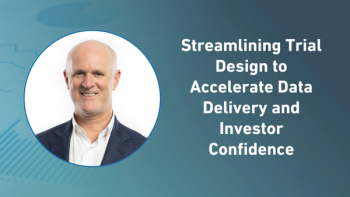
CRO Outlook 2015: A Paperless Path to a Competitive Advantage
All signs indicate that 2015 should be another good year for contract research organizations (CROs).
All signs indicate that 2015 should be another good year for contract research organizations (CROs). A recent Pharmaceutical Technology outsourcing survey shows that one-third of trial sponsors expect their spending to increase by 10% in 2015, and most anticipate spending to be at least the same or slightly higher.1 Good news, for sure. However, nearly half (43%) of those surveyed have reduced, or plan to reduce, their number of outsourced partners.2
So, how can CROs gain competitive advantage?
One way is to increase efficiency and provide sponsors better insight into the trial, which not only improves collaboration with sponsors, but also with sites, regulators, and review boards. Today, many CROs still manage the trial master file (TMF) using paper or simple file shares, according to the
Today’s eTMF applications, however, give CROs greater efficiency, visibility, and compliance and deliver more collaborative relationships with sponsors. Research shows, CROs that have already adopted advanced eTMF solutions report achieving significant benefits (Figure 1), including increased inspection-readiness, higher quality TMFs, and improved collaboration with external partners.3
Building a Technology Foundation for a Trusted Partnership
CROs still using traditional paper or file-share systems to manage clinical documents throughout a trial expend great manual effort to maintain TMF quality and completeness-deeply impacting the relationship with sponsors. Since documents can be stored in both paper and electronic format, there’s greater likelihood of version control challenges-increasing compliance risk, process redundancies, and resulting in duplicate documents that require significant time and effort to reconcile at study close-out. Considering the fact that a typical Phase III study can generate many thousands of documents, managing this content throughout the trial is no trivial matter. Add to this the increasing complexity of study protocols, the global span of clinical development, and the growing number of stakeholders such as investigator sites, agencies, committees, and it’s no wonder the act of assembling trial documents into a coherent and readily accessible TMF has become an organizational drain for CROs and sponsors alike.
There’s a better way. All stakeholders can benefit when using a shared eTMF application in the cloud that provides a single source during the study. All participants access the same documents and associated workflows, helping to increase visibility and control, compliance, and overall efficiency-ultimately fostering a trusted and lasting partnership between CRO and sponsor.
Paperless TMF systems
Paperless TMF systems, easily and securely accessible by all in the cloud, remove barriers between sponsors and CROs to encourage trust and enable real-time information sharing. In fact, CROs using eTMF applications report significant improvements in collaboration with sponsors. Almost half of the CROs surveyed report easier collaboration with sites (45%) and other CROs (49%) with paperless technology.3
Further, many CROs report improvements in real-time tracking and viewing of documents (61%), and increased document quality (43%) with a process-driven eTMF. Jessica Vicari, director of regulatory start-up and document management at Advanced Clinical, a global CRO, noted, “We invested in a cloud eTMF 12-months ago and almost immediately began collaborating more efficiently with sponsors.”
An eTMF application provides a single point of access for both CROs and sponsors throughout the clinical trial-from site feasibility to study start-up and through database lock-so everyone is always working with the most up-to-date versions of documents. With better visibility, sponsors have more control over content and grow increasingly more secure in the relationship. Sponsors can collaborate with CROs in real time, too-without any versioning issues-and still maintain a single source of the truth. “With a cloud-based eTMF, we can provide sponsors with total transparency of trial data and enable a richer, more collaborative partnership for improved trial results,” said Gregg Dearhammer, COO at inVentiv Health Clinical.
Another global CRO, Pharma Start, has increased speed, visibility, and control for its clients since implementing a cloud-based eTMF worldwide across more than 75 investigator sites. “Securely accessible in the cloud and as easy to use as Amazon, our new eTMF ensures both external and internal teams can fully leverage the system. Everyone can work in parallel so we don’t wait, for example, while documents are shipped to sites or a wet signature is captured via courier from locations all around the globe,” explained Rebecca Moraris, director of clinical operations at Pharma Start. “It also provides total transparency and a better vantage point for sponsors, sites, and internal groups to identify problems early and fix them quickly.”
Increase Inspection-readiness
Paperless technology not only improves visibility, collaboration, and control between CROs and sponsors, but also enables inspection-readiness-a top concern of life sciences companies. CROs using advanced eTMF applications report improvements in many inspection areas, including reduction of missing (76%), misfiled (76%), duplicate (72%), incomplete (65%), and expired (62%) documents.3 See Figure 2.
Cloud-based eTMF applications provide convenient access to health authorities, which are increasingly seeking electronic access to the TMF globally. In April 2014, the United Kingdom’s Medicines and Healthcare Products Regulatory Agency (MHRA) updated its definition of a critical good clinical practice (GCP) finding to include TMFs that are incomplete and inaccessible. Ensuring compliance with these guidelines is difficult when most TMFs are still dependent on paper. After repeated inspection delays, the MHRA tightened its parameters on the TMF. In 2013, 33% of sponsor inspections required extra days due to an incomplete TMF or lack of accessibility. Other regulatory authorities around the globe are likely to follow the MHRA’s precedent, putting more scrutiny on TMFs worldwide.
The anytime availability and universal accessibility of cloud-based eTMFs solves this challenge and improves inspection-readiness. Eldin Rammell, a clinical records management expert and managing director at Rammell Consulting, said, “In the face of MHRA’s updated definition for critical findings, it is encouraging that organizations utilizing eTMF applications are experiencing significant benefits in inspection-readiness and business efficiency gains.”
CROs seem to be mired in more paper than sponsors. In fact, they report using more paper than sponsors across all functional areas. Contracts and clinical operations teams are the most reliant on paper-based processes, with 59% of all contracts (52% for sponsors) and 47% of all clinical operations documents (41% for sponsors) reportedly still in paper.3
Likewise, eight in 10 CROs recently surveyed report using email, and 65% still exchange paper TMF documents, whereas a smaller number of sponsors share TMF documentation via email (64%) and paper (52%).3 While email is electronic, it offers few advantages over manual paper exchange methods. It’s faster, but it’s still unstructured communication that is highly insecure and not integrated to the TMF, causing version control issues that need to be reconciled.
One explanation for the continued reliance on paper is outdated perceptions by CROs regarding regulatory concerns over wet ink signatures and institutional review boards and ethics committees’ demands. However, all major health authorities now accept electronic signatures.
Going paperless allows CROs to eliminate slow, risk-prone manual hand-offs, resulting in significant efficiencies that they can pass on to sponsors. CROs that can show these improvements demonstrate competitive advantage. In fact, 63% of CROs surveyed say cost savings is among the top drivers of eTMF adoption.3 In addition, cloud eTMF applications, once defined, can be reused from study to study, speeding start-up on all future studies.
With improved efficiency, collaboration, control, and compliance thanks to the removal of paper, CROs are well-positioned to maintain stronger, more collaborative relationships with sponsors. And, with a lot riding on these relationships, the responsibility to generate change by going electronic may fall more heavily on the shoulders of CROs.
Why Are CROs In the Driver’s Seat?
While both sponsors and CROs stand to benefit from creating industry-wide transformation with new eTMF technology, CROs have the greatest opportunity to positively impact the most number of products in development, given they may touch so many different studies and their corresponding sponsors, whereas one sponsor generally affects just its own products. In an industry where the top eight CROs account for more than 66% of all clinical trials, CROs certainly are in a great position to affect real change.3
As sponsors outsource more clinical operations, including TMF management and oversight, CROs will gain the advantages of automated and streamlined clinical processes. Sponsors benefit from real-time status updates, improved trial quality, and inspection-readiness, and CROs benefit from a more efficient, scalable model that they can leverage across hundreds of trials and thousands of sites. CROs, for example, report large improvements in SOP compliance (41%) and improved document quality with fewer QC findings with their eTMF applications than do sponsors (23% and 43% respectively).3
IDDI, a biostatistical and eClinical services provider headquartered in Belgium, hasn’t looked back since it transitioned to a cloud-based eTMF application. “We were looking to move from our hybrid system [part paper and part online file-share] to a single, digital solution for improved quality, efficiency, and control while allowing our colleagues and clients to easily access data through the cloud,” said Linda Danielson, COO. IDDI migrated most of its active studies to a cloud eTMF in 2013 followed by 40 new studies in 2014, and reports improved partnerships. “Our eTMF enables effective collaboration since sponsors can review, edit, and approve documents in real time.”
Ensuring the Future
Many life sciences companies are on the cusp of evolving from what have been largely manual TMF processes and simple file shares or paper, towards advanced eTMF technologies to enable paperless trials. In fact, the number of TMF owners actively building or evaluating eTMF applications to support efficient collaboration throughout a clinical trial is up from 17% in 2010 to 34% today, according to a 2014 DIA TMF Reference Model survey. In the industry’s push forward, CROs cannot afford to lag behind. There’s too much to lose and much more to gain by taking the lead role in affecting industry-wide change.
“CROs have a tremendous opportunity to distinguish themselves from the pack and position their organizations as long-term partners,” acknowledged Ken Getz, director of sponsored research programs and professor at Tufts CSDD. “There’s a lot at stake for all parties, so it behooves CROs to invest in building and upgrading infrastructure, top talent, and compliant processes to drive more efficient and safer drug development.”
CROs have a significant opportunity to drive wider industry acceptance and use of innovative technology, yet some still appear cautious to adopt fully electronic processes when sponsors are readily embracing them. Leading organizations are already realizing tremendous benefits – from streamlined operations and increased visibility and access for sponsors, to improved collaboration across the clinical ecosystem. These far-sighted organizations are set to establish themselves as long-term partners, critical to the success of their study sponsors.
Jennifer Goldsmith is Vice President of Vault Strategy for Veeva Systems, and can be reached at
Sources:
- Pharmaceutical Technology, “Positive Outlook for Outsourcing,” August 31, 2014. For more, visit:
www.pharmtech.com/pharmtech/Feature+Articles/Positive-Outlook-for-Outsourcing/ArticleStandard/Article/detail/851267?contextCategoryId=43497
- Outsourcing-Pharma.com, “Strategic Partnerships Yet to Fully Catch On,” October 29, 2104. For more, visit:
www.outsourcing-pharma.com/Clinical-Development/Strategic-partnerships-yet-to-fully-catch-on-Tufts-report-finds/?utm_source=newsletter_daily&utm_medium=email&utm_campaign=29-Oct-2014&c=Ogz+yKt5Hqacyp6PbXQ+DazKY43eeIzO
- Veeva Systems, “Veeva 2014 Paperless TMF Survey: The State of CRO,” October 7, 2014. For more, visit:
www.veeva.com/cro-report
Newsletter
Stay current in clinical research with Applied Clinical Trials, providing expert insights, regulatory updates, and practical strategies for successful clinical trial design and execution.






.png)



.png)



.png)
.png)
